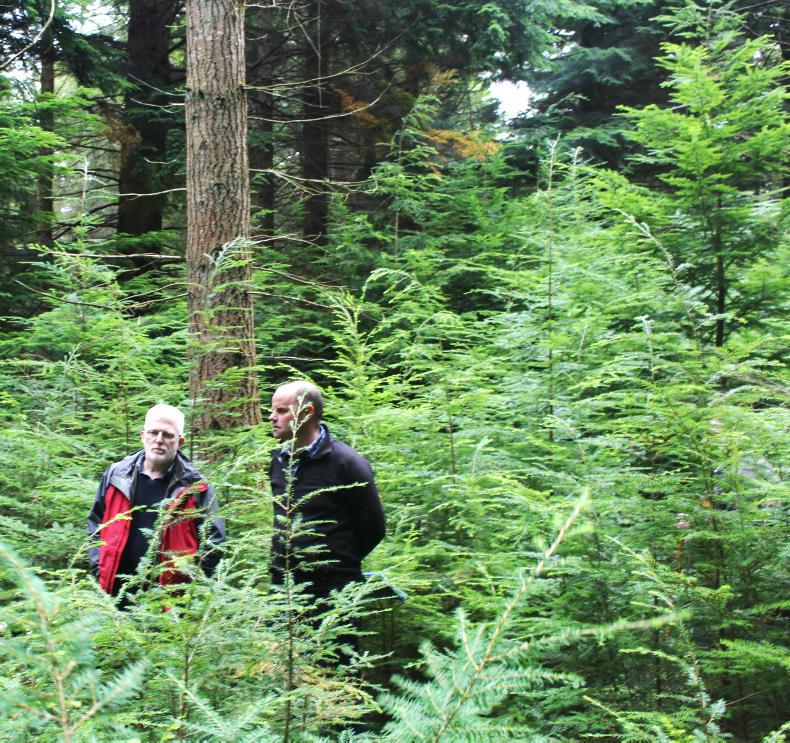In Ireland, we have grown used to a standard way of managing our forests. We plant, maintain, thin the crop at pole stage until it reaches maturity, then we clearfell the forest and begin the cycle all over again. Clear cut is relatively simple. Forecasting volume production and rotation lengths are straightforward. The owners receive a regular income when the crop reaches production stage, culminating with a big payout at clearfell. Then, the owner has to re-invest in the restocking of the next rotation and wait for another 15 to 20 years - depending on species - before the next revenue stream.
But there is another way being proposed by Pro Silva Ireland. This alternative silvicultural approach is known as continuous cover forestry (CCF). Paddy Purser, cofounder of Pro Silva, is an advocate of CCF but says that “it is up to the forest owner to make the decision”.
Judging by the response to the recent Department of Agriculture, Food and the Marine (DAFM) “Support for Transformation to CCF under Element 2 of the Woodland Improvement Scheme”, there is a growing number of forest owners interested in CCF. All 30 pilot projects were taken up within weeks. I asked Paddy Purser about CCF and its future in Irish forestry.
CCF is an alternative to clearcut. Could you describe how it’s different?
CCF differs in that forests are thinned but not clearfelled, therefore becoming permanent forests. Over time, they become more diverse in terms of their species, age classes and structure. Instead of being managed on a rotation basis, the forest is continually thinned through which the capital value of the forest is maintained or increased, while the forest increment, in the form of thinnings (predominantly sawlog material), are removed.
Instead of felling and replanting, the forest is regenerated naturally, using seed produced by the existing stand, hedgerow trees and other nearby tree seed sources. In cases where these sources are not available, enrichment planting is another viable option. CCF also provides the opportunity to diversify timber markets, delivering higher grade timber to niche markets while continuing to supply existing ones.
Is it suitable on all sites and/or all species?
Continuous Cover Forestry is not suitable on all sites, especially peat soils. However, on land that is suitable for forest growth, some form of continuous cover forestry is possible. This may be restricted to native woodland or can be with broadleaved plantations or more commercial conifer stands. CCF management must lead to a more diverse species mix, usually incorporating native species over time. Species mixes depend, just as in conventional forestry, on the soil and site type.
At what stage do you begin conversion to CCF?
The best stage to begin is at forest establishment stage, when appropriate species mixes for the site can be introduced from the start. The next best stage is at the first thinning or tending stage. There are examples of commencing conversion at later stages in a forest rotation and this is achievable depending on the site and forest type although it is more difficult.
The recent quick uptake of the Department CCF scheme took a lot of people by surprise. Did you expect this?
Yes, we in Pro Silva Ireland were not at all surprised by this. There is significant demand both from forest owners and the general public to learn more about CCF and to see it more widely adopted. There are many forest owners who have no intention of ever clearfelling their forests who are crying out for assistance to achieve this. It is the duty of the forestry profession to be able to assist them, and society in general, in this regard.
What are the main challenges facing forest owners who applied for this scheme?
As part of the application process, forest owners are asked to identify the principal challenges they face. While we are not privy to all the applications, I suspect that the types of challenges listed include deer management, lack of experience, lack of forestry contractors with expertise in CCF and commencing transformation with an even-aged monoculture. Pro Silva Ireland members overcome many of these issues through attendance at Pro Silva Ireland field days, training courses and other events as well as through the Pro Silva network which operates throughout 27 European countries.
What is the future for CCF?
CCF in Ireland is rapidly expanding both in the private and public sectors. While it was pioneered in Ireland by private foresters and forest owners, it has now gained support from Teagasc, the Forest Service and Coillte, and is widely supported by the general public and other state and non-governmental organisations with an interest in how forests are managed. The immediate plan for the future is to build capacity amongst foresters, forestry contractors and the forestry sector in general to cope with the demand for CCF.
This will involve the further development of training programmes and demonstration sites of different forest types to instruct and inspire more forest owners who would like their forests to be managed this way. Because CCF delivers multiple forest functions, I expect it will become the management system expected by regulators in sensitive areas where soil, water and habitat protection are paramount.
The experience of ash dieback has been chastening for forest owners and there is a growing sense that a more integrated and resilient forest management model is required, especially in the face of climate change. This is already turning forest owners towards CCF and I believe this trend will continue.
For details on CCF click here.






 This is a subscriber-only article
This is a subscriber-only article









SHARING OPTIONS: